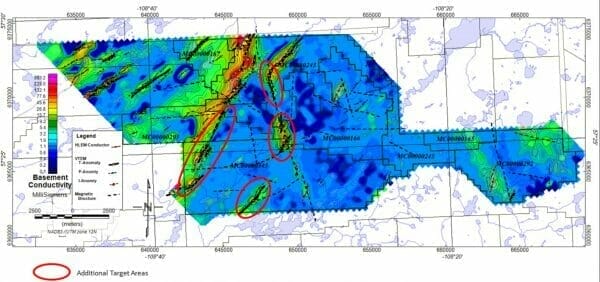Skyharbour Resources’ (SYH.V) partner company Azincourt Energy (AAZ.V) completed their airborne radiometric survey, and is also here with an update on their preparations for their 2021-2022 East Preston uranium project.
The 2021-2022 primary target area is the conductive corridor from A-zone through to G-zone. These selections are based on results from the 2018 through 2020 ground-based electromagnetic (EM) and gravity surveys, property wide Versatile Time Domain Electromagnetic (VTEM) and magnetic surveys, and also the 2019 through 2021 drill programs. Also, the horizontal loop electromagnetic method (HLEM) survey the company completed in December showed multiple prospective conductors and structural complexity along the eastern edge of the corridor.

Skyharbour is a uranium miner with an extensive portfolio of uranium projects in Canada’s Athabasca Basin. It’s positioned itself to benefit from improvements in the uranium market with six drill-ready projects over 240,000 hectares of land. Skyharbour has acquired a 100% interest in the Moore Uranium Project from Denison Mines, a strategic shareholder in the company. The project is located 15 km east of Denison’s Wheeler River project and 39 km south of Cameco’s McArthur River uranium mine. The project has been covered extensively by Equity Guru’s mining maven, Greg Nolan, whose coverage should not be missed.
Radiometric Survey Complete
The company contracted out to Terralogic Exploration to do an airborne radiometric survey over the previously unsurveyed southern portion of the property, and also to conduct field investigations of anything strange which pops up on the scans. Calgary-based Special Project (SPI) conducted the survey using a fixed wing aircraft to complete the survey, which meant 2,514 km of survey lines flown at a low altitude and 50 m line spacing to get good data.
In plain English, they fly over the land, blasting it with a gamma ray blaster called scintillometer, which comes mounted on an airborne platform. It measures and maps the natural radiation put off by the rocks and soil. Gamma radiation is a by-product of the natural decay of elements like uranium, thorium and potassium.
Locations with a higher radiation signature (the anomalies we were talking about) stand out from the rest of the area, and display the potential presence of radioactive bedrock unless there’s something like a glacial till cover, or boulders in the till that could be traced back to a source. Many of the uranium deposits in the Athabasca Basin, including the nearby Triple-R deposit, have been found by following trails of radioactive boulders in the glacial till back to the source.
“The radiometric survey coverage has further highlighted the G-zone and the Q-zone to the
east, reinforcing our decision to focus on these conductive packages at this stage of the project.
I’m eager to see what boots on the ground may yet show based on these results,” said Trevor Perkins,
Azincourt’s VP of exploration.
East Preston
The East Preston deal came about as an option agreement between Skyharbour, Dixie Gold (DG.V) and Azincourt, wherein Azincourt had an earn-in option to acquire a 70% stake in a portion of the Preston uranium project. They’ve since earned their interest in the project by completing CAD$2.5 million in staged exploration expenses and making $1 million in cash payments, and also by issuing 9.5 million common shares of Azincourt divided evenly between Skyharbour and Dixie Gold. Skyharbour retains a 15% interest in the East Preston Project.

Three prospective low magnetic signature corridors have been found on the property with a total strike length of over 25 km, each with multiple EM conductor trends. Ground prospecting and sampling has identified outcrop, soil, biogeochemical and radon anomalies, which are key pathfinder elements for uncomformity uranium deposit discovery.
(Aside: an uncomformity in geological terms is a surface of contact between two groups of unconformable strata. Not necessarily a rebellious way of calling yourself a non-conformist.)
The East Preston Project has multiple long linear conductors with specific changes in orientation and offset breaks around the interpreted fault lineaments, which are classic targets for basement-hosted uncomformity uranium deposits.
What’s next?
The planned diamond drilling program to complete 1,000 meters of drilling left over from the shortened winter program has been rescheduled after consultation with local communities and contractors. This depth will be used ot furhter expand the upcoming extensive winter drill program, which will now consist of approximately 7,000 meters in 30-35 drill holes.
Preparations begin in early December. Target selection is ongoing and will be refined based on what anomalies they find from their airborne survey.
—Joseph Morton
Full disclosure: Skyharbour Resources is an equity.guru marketing client.







